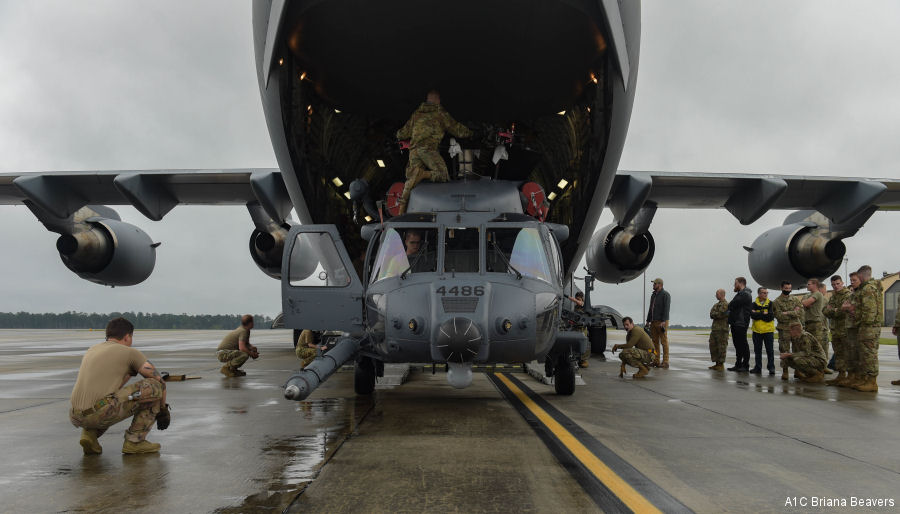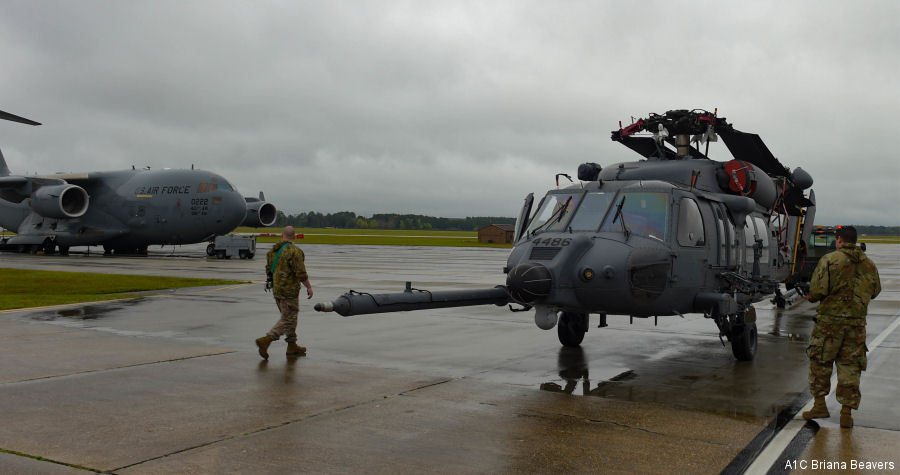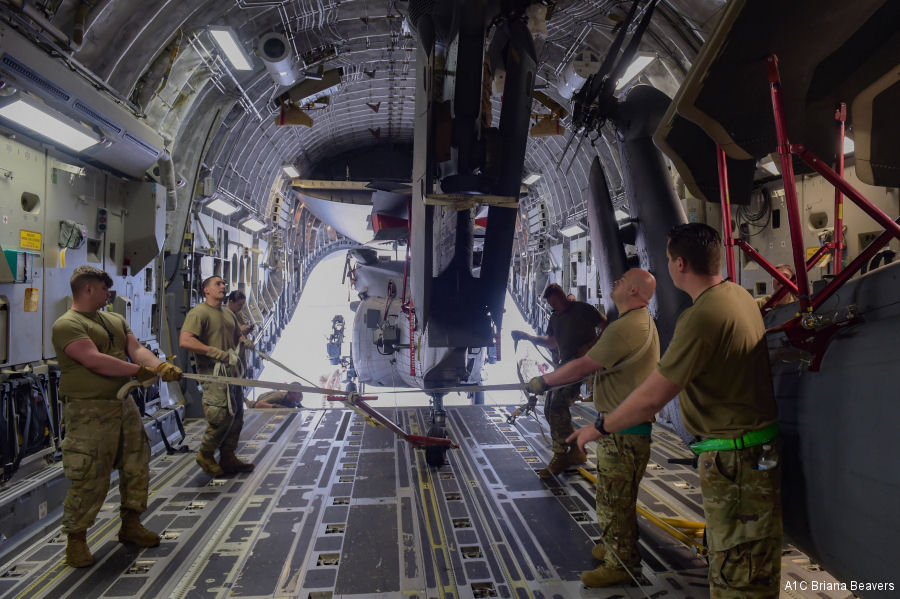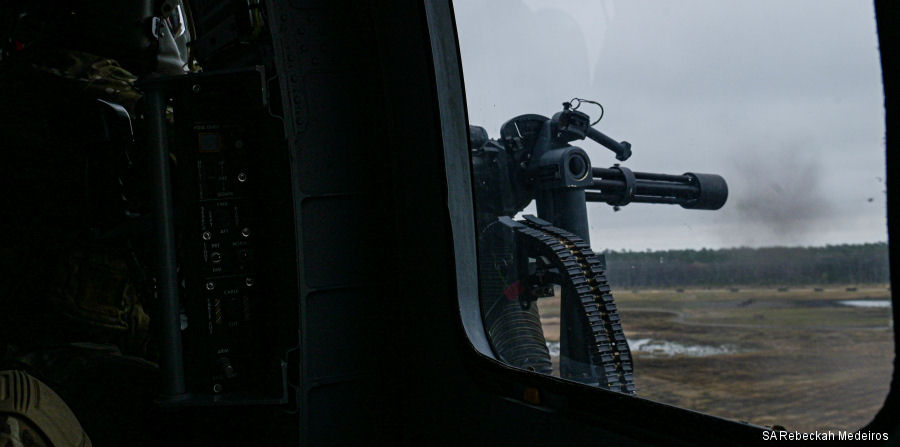
This Air Transportability Testing and Loading Agency, or ATTLA, certification not only allows the 41st RGS to load HH-60W helicopters, but it also certifies the C-17 aircraft to transport them. Furthermore, all Combat Search and Rescue communities with an HH-60W program now have the ability to transport HH-60W helicopters on C-17s anywhere in the world due to this process.
“This is a fleet-wide certification that will impact the entire CSAR community,” said Master Sgt. Jeffrey Tessendorf, 41st RGS lead production superintendent. “Any base that flies an HH-60W will now be able to utilize a C-17 for transport just because the 41st set this standard.”
The employment of C-17s for transport effectively shortens the amount of time it takes to engage CSAR operations around the globe.
“(This process) provides that worldwide capability,” said Tessendorf. ”If we get the call, we can have an aircraft folded within four hours, loaded on a C-17 and flown to a (contested location) within two days versus flying an (HH-60W) which would take about a week.”
In addition to faster employment of aircraft, the 41st RGS is able to increase the number of aircraft provided due to the certification.
“The initial certification was for one (HH-60W),” said said Maj. Thomas Bihansky, 41st RGS commander, “but our airmen realized that they could load two aircrafts on the C-17. This saves the entire Air Force fleet when we have to deploy somewhere by allowing us to get more aircraft out to a combat unit faster.”
As the 23rd Wing prepares to be Lead-Wing ready, capabilities such as these become vital to the wing’s success.
“CSAR is a key part of the Lead-Wing concept,” said Bihansky. “This certification allows us to deploy anywhere in the world at any time and wherever contingency or combat operations require us to be. It’s vital we get these aircraft to the fight when called upon.”
Getting these aircraft to the fight greatly depends on the warfighting maintainers of the rescue community.
This certification is a huge achievement for the 41st RGS Whiskey program and our Airmen, said Bihansky. It brings the rescue community one step closer to being combat capable and Lead-Wing ready. This certification guarantees that all HH-60W models are transportable on C-17s until they retire from service.
First HH-60W firing the GAU-21 and GAU-2 machine guns
MOODY AIR FORCE BASE, Georgia by Staff Sgt Jordan Garner and Senior Airman Rebeckah Medeiros - The 41st Rescue Squadron became the first in the U.S. Air Force to test-fire the GAU-21 (FN M3M Browning) and GAU-2 (M134 Minigun) weapons systems on the HH-60W Jolly Green II helicopter at Moody Air Force Base, Georgia, March 2022.
The 41st RQS trained on the weapons systems to set a baseline of combat search and rescue (CSAR) tactics, techniques and procedures (TTP) for the entire Air Force rescue community with HH-60W aircraft in their inventory.
Since the 23rd Wing replaced all HH-60G Pave Hawk aircraft with the newer Whiskey model, the 41st RQS and 41st Rescue Generation Squadron have made it their mission to get their Airmen up to speed with the new assets.
“We’re the only combat force in the entire Department of Defense and the whole world, which is a dedicated force that solely does personnel recovery behind enemy lines in a high-risk environment,” said Lt. Col. Thad Ronnau, 41st RQS commander. “It becomes vital that we perfect the art of CSAR, train this and the next generation effectively and have a truly combat-ready force any combatant command can rely on to execute the mission.”
With the new weapons systems, pilots and special missions aviators can accomplish CSAR operations more effectively and safely.
“There’s a lot of new stuff they added to the (GAU-2) that really has improved it, like the fact that it runs on a separate battery system,” said Master Sgt. John Rosenberg, 347th Operations Support Squadron weapons and tactics superintendent. “Those things add an extreme tactical advantage, because if you have to put the aircraft down somewhere you don’t want to put it down, you can still defend it without it running.”
Due to the risks of CSAR, having the capability to defend themselves and the aircraft in any scenario is critical. However, every new capability requires hours of practice and refining to ensure successful employment.
With the help of the 88th Test and Evaluation Squadron Detachment 2, the 41st RQS was able to sharpen these TTPs while communicating issues and resolving problems more quickly and efficiently, facilitating the process to become fully combat ready.
“The TTPs that we come up with are printed in a manual, so anybody that flies in the community of the HH-60W can reference them until they’re rewritten or adapted,” said Maj. Evan McNeal, 88th TES Det 2 director of operations. “It gives them a best use case for whatever mission or objective they have, and that’s what sets them up for the most success.”
Keeping up with emerging technology is one way the rescue community improves their CSAR capabilities. However, without deliberate training, the newer equipment will only get them so far.
“The advantages and disadvantages of this system, or any system, is the training, and I think the 41st is going in the right direction getting as many people trained on this,” Rosenberg said. “This is an impressive weapons system, but what’s most impressive is the way the squadron is moving forward training the guys to use it.”
Rosenberg said it’s crucial for the Airmen to challenge themselves every day to maintain readiness, and Airmen throughout the CSAR community agree.
“Being constantly in the game, thinking about how we’re going to do our job is vitally important because we have to get those guys out of harm’s way,” McNeal said about rescuing downed aircrew.
As the 41st RQS and 88th TES continue to analyze data collected through training, the rescue squadron will share their findings and best practices throughout the rest of the Air Force. . The TTPs will be accessible and updated to all HH-60W operators to reference and provide information so training can be accurate and efficient.
Advancements like these also support Air Combat Command’s goal for Team Moody to be Lead-Wing ready by October of 2022.


HH-60W folded for airlift on C-17

GAU-21 / M134 minigun firing by HH-60W
Comments | Join community |
| Great to see the ongoing development of the 60, including the M-134 mini-gun firing. Is there anything this beast cannot do? #AceHawk #AceAero #Airlift #NMH |
| And you can put 2 in the back of a C-17 with minimal prep ;-) |
| That has to be top of the list of things everybody loves about the Hawk - little or no development costs and the kit really works. |
See also |
HH-60W Jolly Green II in
41st RQS




